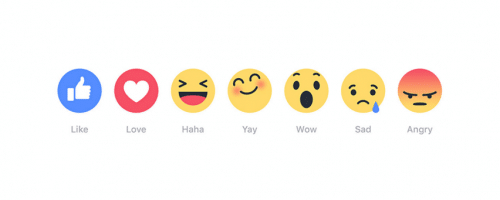Let’s Talk About: Facebook’s new “Reactions” functionality.
Facebook recently released new “Reactions” to use when interacting with posts. Beyond just “liking” a post, you can now select “love,” “haha,” “wow,” “sad,” and “angry.”
Mark Zuckerberg described the new feature like this:
“Today is our worldwide launch of Reactions — the new Like button with more ways to express yourself. Not every moment you want to share is happy. Sometimes you want to share something sad or frustrating. Our community has been asking for a dislike button for years, but not because people want to tell friends they don’t Like their posts. People wanted to express empathy and make it comfortable to share a wider range of emotions.
I’ve spent a lot of time thinking about the right way to do this with our team. One of my goals was to make it as simple as pressing and holding the Like button. The result is Reactions, which allow you to express love, laughter, surprise, sadness or anger.
Love is the most popular reaction so far, which feels about right to me!”
When it comes to measuring engagement, the Facebook Newsroom announced that each of these new reactions will be counted as a Like. (Although it appears that Facebook plans on letting brands view engagements broken out by reactions on the Insights tab in the future.)
Our POV:
This is one of the biggest game-changers that Facebook has introduced to its UX since it started in 2004. We say “big” because it greatly influences how users engage with the platform. Even though it’s a relatively minor function, it still has greater implications.
For users, it means we can mark the stories that matter most to us, and our Newsfeed could potentially react to that data. By telling Facebook not just what you like to see (or don’t like to see) – but how you’re FEELING about it – they can start serving you with content that takes your shared mood into account, or perhaps content that just feels more personalized.
For brands, the changes could impact their content and their ad targeting. Although Facebook’s current plan is to count everything as a Like, brands would benefit from more granular insights into the type of emotions associated with specific content. Users can tell us if our content is relevant to them, or not. Obviously if users “love” a post, it’s content that they want to see more of, which is something the content strategist can chalk up as a home run. But now, if your users only Like a post, we have to wonder: was it really worth posting at all?
We also begin to wonder how this will influence the Facebook sphere overall. Will people begin to judge their friends’ reactions to their posts? Will this start to turn people away from the platform? Or, will we start to see the number of engagements increase now that users can assign a specific emotion when a generic Like wouldn’t have worked in the past? Only time will tell, but we suspect that it won’t have huge negative implications. Hopefully, the new reactions will lead to deeper insights into the true sentiment behind a Like, which should mean improved content for all.
Reactions from Creators:
Kat, Copywriter & Strategist: I can’t wait to start seeing reactions to our client content! I’m excited about the prospect of getting more insight into how users are feeling about social content we create, particularly when it comes to copy. I’m wondering if we can “test” content (or make recommendations) based on reactions.
Christen, Strategist: I’m hoping reactions will help us better understand what a brand’s users are feeling or thinking. Some may be concerned about having too many choices, but in this case, I think it’s a welcome change. Users have been practically begging Facebook for more than a Like, and they finally delivered!
Sarah, Art Director: From a UX perspective, I know this was a huge undertaking. I’m excited by the simplicity of their solution and look forward to seeing how their initial decisions evolve over time. It looks like the ‘yay’ emoji didn’t make the cut, so I will be rallying for it’s future inclusion.




